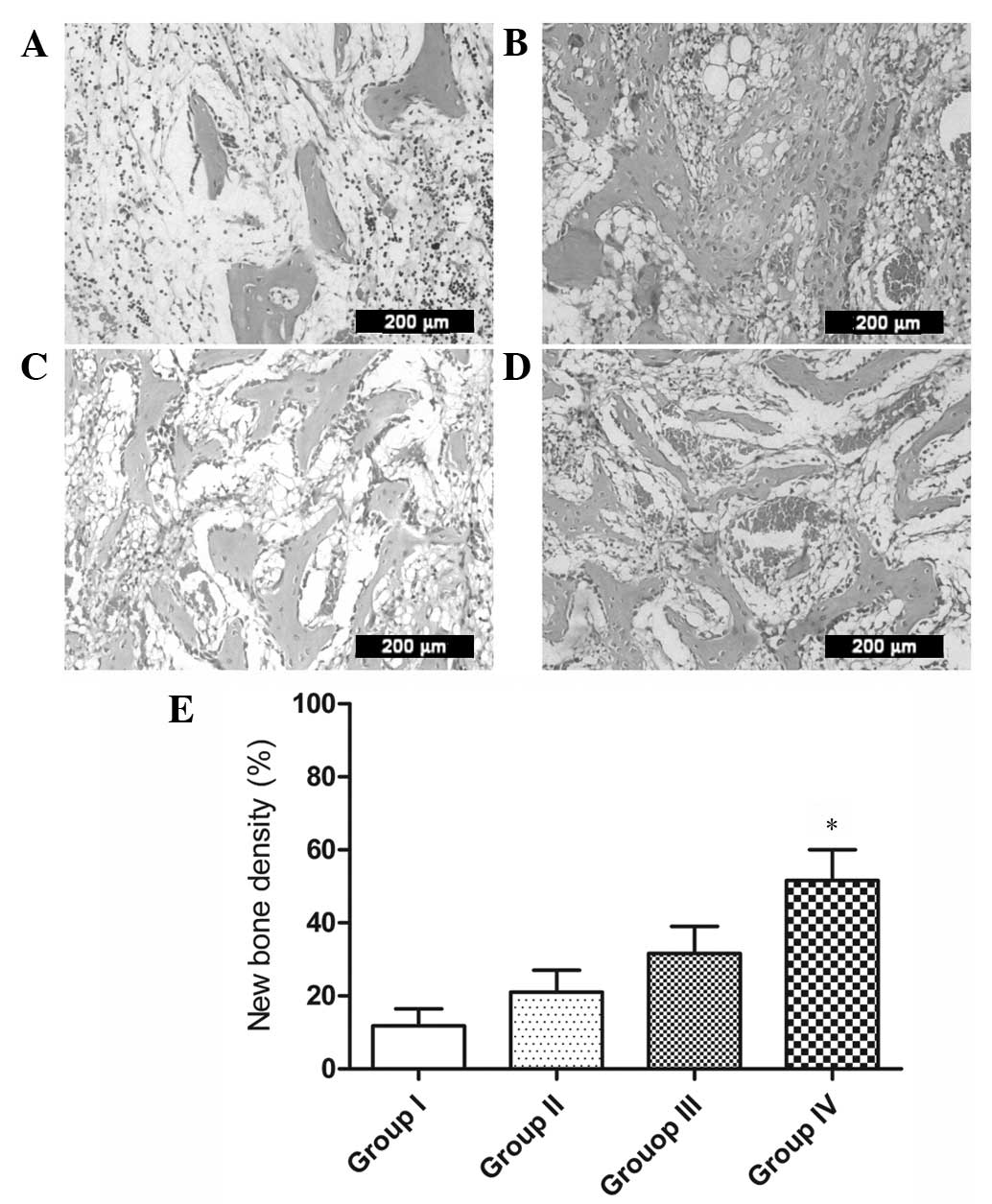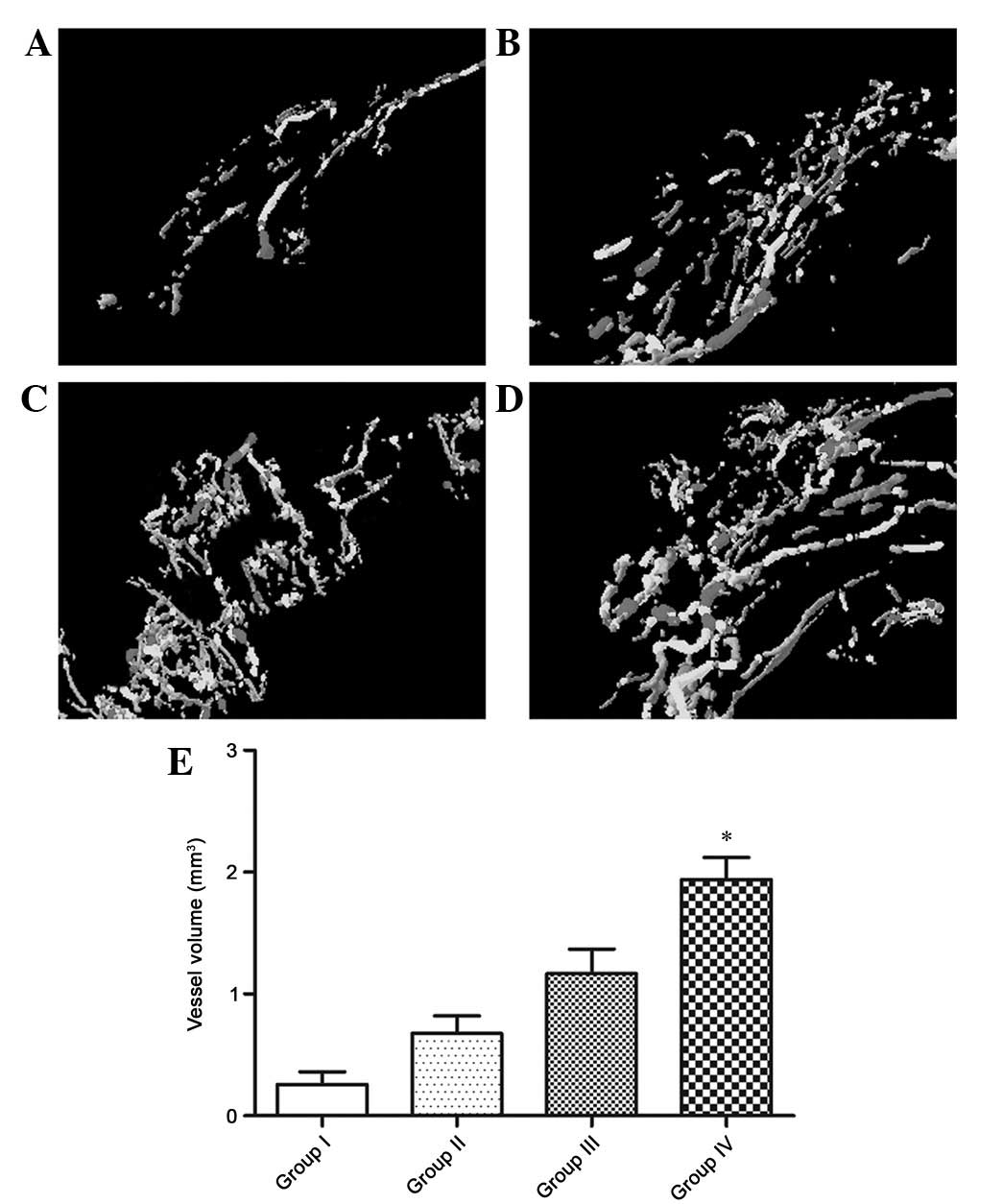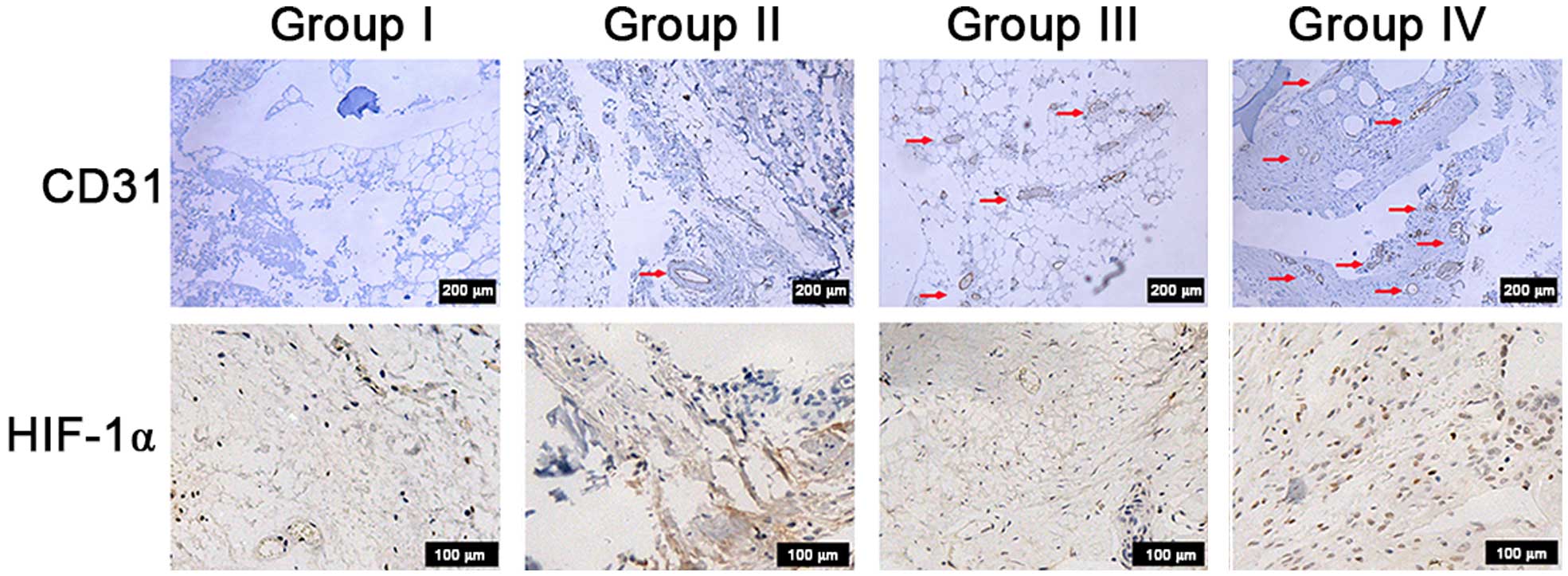|
1
|
Kerachian MA, Harvey EJ, Cournoyer D, Chow
TY and Séguin C: Avascular necrosis of the femoral head: Vascular
hypotheses. Endothelium. 13:237–244. 2006. View Article : Google Scholar : PubMed/NCBI
|
|
2
|
Bachiller FG, Caballer AP and Portal LF:
Avascular necrosis of the femoral head after femoral neck fracture.
Clin Orthop Relat Res. 87–109. 2002. View Article : Google Scholar : PubMed/NCBI
|
|
3
|
Lieberman JR, Berry DJ, Mont MA, Aaron RK,
Callaghan JJ, Rajadhyaksha AD and Urbaniak JR: Osteonecrosis of the
hip: Management in the 21st century. Instr Course Lect. 52:337–355.
2003.PubMed/NCBI
|
|
4
|
Yoon TR, Song EK, Rowe SM and Park CH:
Failure after core decompression in osteonecrosis of the femoral
head. Int Orthop. 24:316–318. 2001. View Article : Google Scholar : PubMed/NCBI
|
|
5
|
Yuan J, Cui L, Zhang WJ, Liu W and Cao Y:
Repair of canine mandibular bone defects with bone marrow stromal
cells and porous beta-tricalcium phosphate. Biomaterials.
28:1005–1013. 2007. View Article : Google Scholar : PubMed/NCBI
|
|
6
|
Liu G, Zhao L, Zhang W, Cui L, Liu W and
Cao Y: Repair of goat tibial defects with bone marrow stromal cells
and beta-tricalcium phosphate. J Mater Sci Mater Med. 19:2367–2376.
2008. View Article : Google Scholar : PubMed/NCBI
|
|
7
|
Stamm C, Westphal B, Kleine HD, Petzsch M,
Kittner C, Klinge H, Schümichen C, Nienaber CA, Freund M and
Steinhoff G: Autologous bone-marrow stem-cell transplantation for
myocardial regeneration. Lancet. 361:45–46. 2003. View Article : Google Scholar : PubMed/NCBI
|
|
8
|
Schächinger V, Erbs S, Elsässer A,
Haberbosch W, Hambrecht R, Hölschermann H, Yu J, Corti R, Mathey
DG, Hamm CW, et al: Intracoronary bone marrow-derived progenitor
cells in acute myocardial infarction. N Engl J Med. 355:1210–1221.
2006. View Article : Google Scholar : PubMed/NCBI
|
|
9
|
Dadon-Nachum M, Sadan O, Srugo I, Melamed
E and Offen D: Differentiated mesenchymal stem cells for sciatic
nerve injury. Stem Cell Rev. 7:664–671. 2011. View Article : Google Scholar : PubMed/NCBI
|
|
10
|
Yang Y, Hallgrimsson B and Putnins EE:
Craniofacial defect regeneration using engineered bone marrow
mesenchymal stromal cells. J Biomed Mater Res A. 99:74–85. 2011.
View Article : Google Scholar : PubMed/NCBI
|
|
11
|
Gangji V, De Maertelaer V and Hauzeur JP:
Autologous bone marrow cell implantation in the treatment of
non-traumatic osteonecrosis of the femoral head: Five year
follow-up of a prospective controlled study. Bone. 49:1005–1009.
2011. View Article : Google Scholar : PubMed/NCBI
|
|
12
|
Tzaribachev N, Vaegler M, Schaefer J,
Reize P, Rudert M, Handgretinger R and Müller I: Mesenchymal
stromal cells: A novel treatment option for steroid-induced
avascular osteonecrosis. Isr Med Assoc J. 10:232–234.
2008.PubMed/NCBI
|
|
13
|
Cowan CM, Shi YY, Aalami OO, Chou YF, Mari
C, Thomas R, Quarto N, Contag CH, Wu B and Longaker MT:
Adipose-derived adult stromal cells heal critical-size mouse
calvarial defects. Nat Biotechnol. 22:560–567. 2004. View Article : Google Scholar : PubMed/NCBI
|
|
14
|
Dudas JR, Marra KG, Cooper GM, Penascino
VM, Mooney MP, Jiang S, Rubin JP and Losee JE: The osteogenic
potential of adipose-derived stem cells for the repair of rabbit
calvarial defects. Ann Plast Surg. 56:543–548. 2006. View Article : Google Scholar : PubMed/NCBI
|
|
15
|
Nikol S, Engelmann MG, Pelisek J, Fuchs A,
Golda A, Shimizu M, Mekkaoui C and Rolland PH: Local perivascular
application of low amounts of a plasmid encoding for vascular
endothelial growth factor (VEGF165) is efficient for therapeutic
angiogenesis in pigs. Acta Physiol Scand. 176:151–159. 2002.
View Article : Google Scholar : PubMed/NCBI
|
|
16
|
Elçin YM, Dixit V and Gitnick G: Extensive
in vivo angiogenesis following controlled release of human vascular
endothelial cell growth factor: Implications for tissue engineering
and wound healing. Artif Organs. 25:558–565. 2001. View Article : Google Scholar : PubMed/NCBI
|
|
17
|
Mazumdar J, Dondeti V and Simon MC:
Hypoxia-inducible factors in stem cells and cancer. J Cell Mol Med.
13:4319–4328. 2009. View Article : Google Scholar : PubMed/NCBI
|
|
18
|
Zou D, Zhang Z, Ye D, Tang A, Deng L, Han
W, Zhao J, Wang S, Zhang W, Zhu C, et al: Repair of critical-sized
rat calvarial defects using genetically engineered bone
marrow-derived mesenchymal stem cells overexpressing
hypoxia-inducible factor-1α. Stem Cells. 29:1380–1390.
2011.PubMed/NCBI
|
|
19
|
Ding H, Gao YS, Hu C, Wang Y, Wang CG, Yin
JM, Sun Y and Zhang CQ: HIF-1α transgenic bone marrow cells can
promote tissue repair in cases of corticosteroid-induced
osteonecrosis of the femoral head in rabbits. PLoS One.
8:e636282013. View Article : Google Scholar : PubMed/NCBI
|
|
20
|
Cesana D, Ranzani M, Volpin M, Bartholomae
C, Duros C, Artus A, Merella S, Benedicenti F, Sergi L Sergi,
Sanvito F, et al: Uncovering and dissecting the genotoxicity of
self-inactivating lentiviral vectors in vivo. Mol Ther. 22:774–785.
2014. View Article : Google Scholar : PubMed/NCBI
|
|
21
|
Jaakkola P, Mole DR, Tian YM, Wilson MI,
Gielbert J, Gaskell SJ, von Kriegsheim A, Hebestreit HF, Mukherji
M, Schofield CJ, et al: Targeting of HIF-alpha to the von
Hippel-Lindau ubiquitylation complex by O2-regulated prolyl
hydroxylation. Science. 292:468–472. 2001. View Article : Google Scholar : PubMed/NCBI
|
|
22
|
Ding H, Gao YS, Wang Y, Hu C, Sun Y and
Zhang C: Dimethyloxaloylglycine increases the bone healing capacity
of adipose-derived stem cells by promoting osteogenic
differentiation and angiogenic potential. Stem Cells Dev.
23:990–1000. 2014. View Article : Google Scholar : PubMed/NCBI
|
|
23
|
National Research Council Institute for
Laboratory Animal Research, . Guide for the Care and Use of
Laboratory Animals. National Academies Press; Washington, DC:
1996
|
|
24
|
Ding H, Chen S, Yin JH, Xie XT, Zhu ZH,
Gao YS and Zhang CQ: Continuous hypoxia regulates the osteogenic
potential of mesenchymal stem cells in a time-dependent manner. Mol
Med Rep. 10:2184–2190. 2014.PubMed/NCBI
|
|
25
|
Qin L, Zhang G, Sheng H, Yeung KW, Yeung
HY, Chan CW, Cheung WH, Griffith J, Chiu KH and Leung KS: Multiple
bioimaging modalities in evaluation of an experimental
osteonecrosis induced by a combination of lipopolysaccharide and
methylprednisolone. Bone. 39:863–871. 2006. View Article : Google Scholar : PubMed/NCBI
|
|
26
|
Sun Y, Feng Y and Zhang C: The effect of
bone marrow mononuclear cells on vascularization and bone
regeneration in steroid-induced osteonecrosis of the femoral head.
Joint Bone Spine. 76:685–690. 2009. View Article : Google Scholar : PubMed/NCBI
|
|
27
|
Griffith JF, Antonio GE, Kumta SM, Hui DS,
Wong JK, Joynt GM, Wu AK, Cheung AY, Chiu KH, Chan KM, et al:
Osteonecrosis of hip and knee in patients with severe acute
respiratory syndrome treated with steroids. Radiology. 235:168–175.
2005. View Article : Google Scholar : PubMed/NCBI
|
|
28
|
Ohzono K, Saito M, Sugano N, Takaoka K and
Ono K: The fate of nontraumatic avascular necrosis of the femoral
head. A radiologic classification to formulate prognosis. Clin
Orthop Relat Res. 277:73–78. 1992.
|
|
29
|
Hopson CN and Siverhus SW: Ischemic
necrosis of the femoral head. Treatment by core decompression. J
Bone Joint Surg Am. 70:1048–1051. 1988.PubMed/NCBI
|
|
30
|
Maniwa S, Nishikori T, Furukawa S,
Kajitani K, Iwata A, Nishikawa U and Ochi M: Evaluation of core
decompression for early osteonecrosis of the femoral head. Arch
Orthop Trauma Surg. 120:241–244. 2000. View Article : Google Scholar : PubMed/NCBI
|
|
31
|
Dailiana ZH, Toth AP, Gunneson E, Berend
KR and Urbaniak JR: Free vascularized fibular grafting following
failed core decompression for femoral head osteonecrosis. J
Arthroplasty. 22:679–688. 2007. View Article : Google Scholar : PubMed/NCBI
|
|
32
|
Scully SP, Aaron RK and Urbaniak JR:
Survival analysis of hips treated with core decompression or
vascularized fibular grafting because of avascular necrosis. J Bone
Joint Surg Am. 80:1270–1275. 1998.PubMed/NCBI
|
|
33
|
Jones JP Jr: Concepts of etiology and
early pathogenesis of osteonecrosis. Instr Course Lect. 43:499–512.
1994.PubMed/NCBI
|
|
34
|
Hernigou P, Beaujean F and Lambotte JC:
Decrease in the mesenchymal stem-cell pool in the proximal femur in
corticosteroid-induced osteonecrosis. J Bone Joint Surg Br.
81:349–355. 1999. View Article : Google Scholar : PubMed/NCBI
|
|
35
|
Gangji V, Hauzeur JP, Schoutens A,
Hinsenkamp M, Appelboom T and Egrise D: Abnormalities in the
replicative capacity of osteoblastic cells in the proximal femur of
patients with osteonecrosis of the femoral head. J Rheumatol.
30:348–351. 2003.PubMed/NCBI
|
|
36
|
Lee JS, Lee JS, Roh HL, Kim CH, Jung JS
and Suh KT: Alterations in the differentiation ability of
mesenchymal stem cells in patients with nontraumatic osteonecrosis
of the femoral head: Comparative analysis according to the risk
factor. J Orthop Res. 24:604–609. 2006. View Article : Google Scholar : PubMed/NCBI
|
|
37
|
Yan ZQ, Chen YS, Li WJ, Yang Y, Huo JZ,
Chen ZR, Shi JH and Ge JB: Treatment of osteonecrosis of the
femoral head by percutaneous decompression and autologous bone
marrow mononuclear cell infusion. Chin J Traumatol. 9:3–7.
2006.PubMed/NCBI
|
|
38
|
Riddle RC, Khatri R, Schipani E and
Clemens TL: Role of hypoxia-inducible factor-1alpha in
angiogenic-osteogenic coupling. J Mol Med (Berl). 87:583–590. 2009.
View Article : Google Scholar : PubMed/NCBI
|
|
39
|
Piret JP, Lecocq C, Toffoli S, Ninane N,
Raes M and Michiels C: Hypoxia and CoCl2 protect HepG2 cells
against serum deprivation- and t-BHP-induced apoptosis: A possible
anti-apoptotic role for HIF-1. Exp Cell Res. 295:340–349. 2004.
View Article : Google Scholar : PubMed/NCBI
|
|
40
|
Ockaili R, Natarajan R, Salloum F, Fisher
BJ, Jones D, Fowler AA III and Kukreja RC: HIF-1 activation
attenuates postischemic myocardial injury: Role for heme
oxygenase-1 in modulating microvascular chemokine generation. Am J
Physiol Heart Circ Physiol. 289:H542–H548. 2005. View Article : Google Scholar : PubMed/NCBI
|
|
41
|
Milkiewicz M, Pugh CW and Egginton S:
Inhibition of endogenous HIF inactivation induces angiogenesis in
ischaemic skeletal muscles of mice. J Physiol. 560:21–26. 2004.
View Article : Google Scholar : PubMed/NCBI
|
|
42
|
Nagel S, Papadakis M, Chen R, Hoyte LC,
Brooks KJ, Gallichan D, Sibson NR, Pugh C and Buchan AM:
Neuroprotection by dimethyloxalylglycine following permanent and
transient focal cerebral ischemia in rats. J Cereb Blood Flow
Metab. 31:132–143. 2011. View Article : Google Scholar : PubMed/NCBI
|
|
43
|
Ding H, Chen S, Song WQ, Gao YS, Guan JJ,
Wang Y, Sun Y and Zhang CQ: Dimethyloxaloylglycine improves
angiogenic activity of bone marrow stromal cells in the
tissue-engineered bone. Int J Biol Sci. 10:746–756. 2014.
View Article : Google Scholar : PubMed/NCBI
|



















